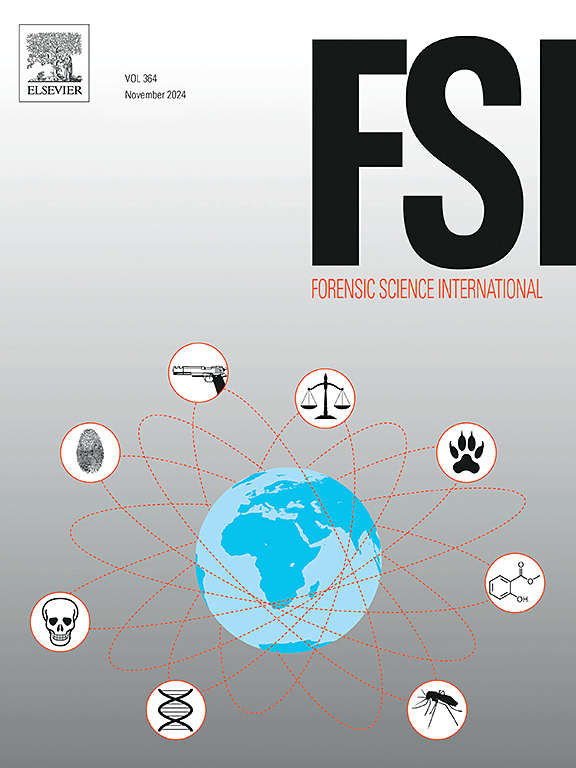在加拿大魁北克省开发用于情报方面的甲基苯丙胺化学分析程序
IF 2.2
3区 医学
Q1 MEDICINE, LEGAL
引用次数: 0
摘要
本文介绍了一种对缴获的甲基苯丙胺片进行化学分析的新方法。这种方法首次在加拿大魁北克省的省法医实验室(LSJML,省法医实验室)进行。主要目的是提供有关魁北克省生产和贩运甲基苯丙胺片剂的资料。采用气相色谱-质谱(GC-MS)对样品进行分析,选取12种相关杂质进行化学分类。数据通过归一化到峰值响应的和,然后是平方根进行预处理。然后计算连接样本和未连接样本的总体之间的曼哈顿距离。该方法被证明能有效地区分两个种群。建立了一个包含所有分析样本的资料的综合数据库,并继续更新。该数据库包含有关纯度、化学类别、切割剂的存在和每个标本的物理特性的信息。如果有系统地应用,这种方法应突出正在进行的案件与数据库中储存的案件之间的联系,并便于根据传统警察案件工作预先选定的案件之间的比较。将甲基苯丙胺片剂化学分析的结果与其他有关的执法数据结合起来,将获得宝贵的战术和行动情报以及战略情报。该项目为调查人员提供了一个额外的工具,可以区分有关联和无关联的甲基苯丙胺标本。虽然需要进一步研究以确定该工具了解甲基苯丙胺生产和分销网络的能力,但它显示出有助于在加拿大魁北克省打击非法生产和贩运的潜力。本文章由计算机程序翻译,如有差异,请以英文原文为准。
Development of a methamphetamine chemical profiling program in Quebec, Canada for use in an intelligence perspective
This paper describes a new method for the chemical profiling of seized methamphetamine tablets. This method was performed for the first time in Quebec, Canada, at the Laboratoire de sciences judiciaires et de médecine légale (LSJML, Provincial Forensic Laboratory). The main objective was to provide information related to the production and trafficking of methamphetamine tablets in the province of Quebec. Samples were analyzed using Gas Chromatography-Mass Spectrometry (GC-MS) and 12 relevant impurities were selected to establish the chemical class. Data were pretreated by the normalization to the sum of peak responses followed by the square roots. The Manhattan distance was then calculated between population of linked samples and unlinked samples. The method proved to efficiently discriminate between the two populations. A comprehensive database containing the profiles of all analyzed samples was established and continues to be updated. The database incorporates information about purity, chemical class, presence of cutting agents and physical characteristics of each specimen. If systematically applied, this methodology should highlight connections between ongoing cases and those stored in the database, as well as facilitate comparisons between preselected cases based on traditional police casework. Integrating the results of methamphetamine tablet chemical profiling with other pertinent law enforcement data will yield valuable tactical and operational intelligence as well as strategic intelligence. This project brings an additional tool to investigators with the differentiation of linked and unlinked methamphetamine specimens. Although further research is required to determine the tool’s capacity to understand methamphetamine production and distribution networks, it shows potential for contributing to efforts against illicit production and trafficking in the province of Quebec, Canada.
求助全文
通过发布文献求助,成功后即可免费获取论文全文。
去求助
来源期刊

Forensic science international
医学-医学:法
CiteScore
5.00
自引率
9.10%
发文量
285
审稿时长
49 days
期刊介绍:
Forensic Science International is the flagship journal in the prestigious Forensic Science International family, publishing the most innovative, cutting-edge, and influential contributions across the forensic sciences. Fields include: forensic pathology and histochemistry, chemistry, biochemistry and toxicology, biology, serology, odontology, psychiatry, anthropology, digital forensics, the physical sciences, firearms, and document examination, as well as investigations of value to public health in its broadest sense, and the important marginal area where science and medicine interact with the law.
The journal publishes:
Case Reports
Commentaries
Letters to the Editor
Original Research Papers (Regular Papers)
Rapid Communications
Review Articles
Technical Notes.
 求助内容:
求助内容: 应助结果提醒方式:
应助结果提醒方式:


